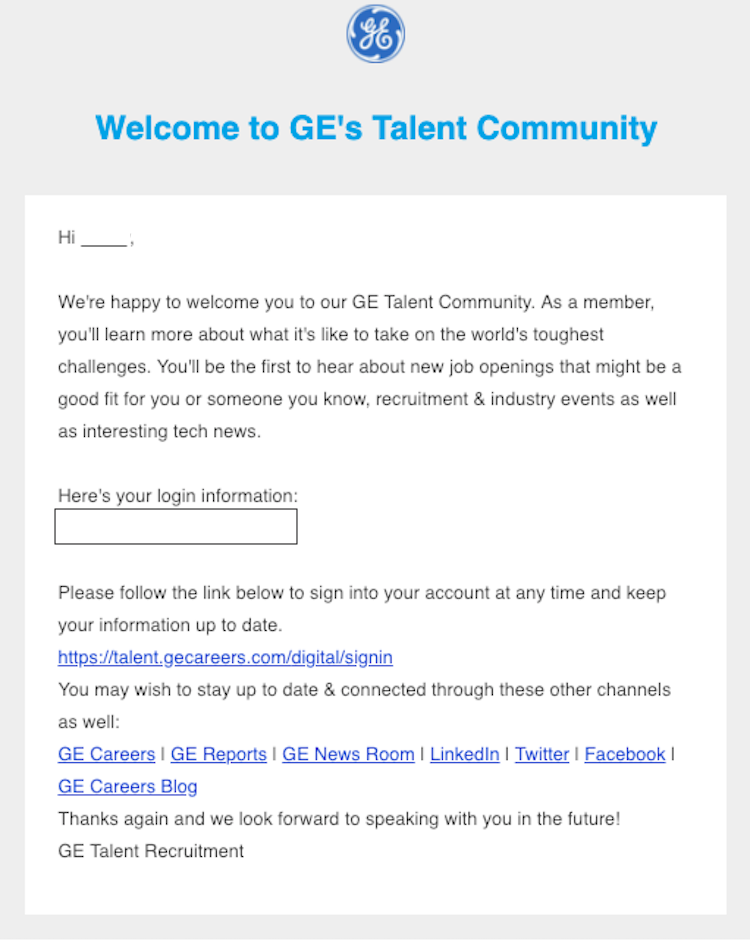You've found the one. The perfect candidate.
After exchanging emails, phone calls, texts and a few LinkedIn messages, you met for the first time in person, and it was nothing short of magic. Within hours you had proposed an offer they just couldn't refuse.
And yet, they did.
That perfect candidate rejected your job offer after you exhausted time, money and resources over the course of several weeks, or even months during the recruiting process, and you're feeling distraught. It’s ok, this is natural.
But before you drown your sorrows in a pint of Haagen Dazs and start sending them creepy 3 AM text messages, remember that just because the candidate said no today doesn’t mean they’ll say no forever. With a well thought out talent community on your side, you’ll have the opportunity to nurture your relationship and eventually win them over when the timing is right.
So what is a talent community? Let’s dive into the nuts and bolts.
See how your employer brand is performing in AI tools like ChatGPT and Google.
Table of Contents
- What is a Talent Community?
- Why Build a Talent Community?
- How to Build a Talent Community
- 5 Best Talent Community Examples
What Is A Talent Community?

A talent community is a cohort of people who would be exceptional candidates for your company, but present circumstances prevent them from joining your team.
While they take many forms, talent communities are most often manifested as digital networks that allow candidates to maintain a relationship with your company even when they aren’t actively under consideration for a role. This can include a candidate-focused email newsletter, social media networks, resume/candidate databases and more.
Maybe you interviewed an ideal candidate, but they weren’t quite right for the role that was open. Or maybe they were your top candidate, but for whatever reason they were unable or unwilling to accept the position at that time.
Rather than lose these prospective candidates forever, a talent community will keep them in your circle for the next time a role opens up and help you stay top of mind when they're considering a change.
This may come as a surprise, but you already have a talent community. Yup, anyone who has shown interest in your company as a potential employer, applied to an open role or even received an offer for a role they didn’t accept — they’re all members of your talent community.
Whether or not you utilize this community in a resourceful way is up to you.
Why Build A Talent Community?

To save time, money and resources hiring top talent. Really, it’s as simple as that.
Here are just few examples of why you should build a talent community:
- Decrease time to fill with an established pool of interested candidates.
- Optimize cost per hire each time you invest in prospective candidates.
- Keep your company top of mind with both passive and active candidates.
- Reserve more time to focus on top candidates in your talent pipeline.
- Save time sourcing candidates with automation and mass content distribution.
Your team has put in a lot of time and resources to attract candidates, convince them to apply and schedule interviews. While it may feel like a major loss if the candidate doesn’t accept or they weren’t quite right for the role, building a talent community will help you better utilize the resources and talent you’ve already invested.
How To Build A Talent Community
Alright, you get the what and why. Now let's walk through the step-by-step process of how to build a powerful talent community.
1. Choose a Talent Community Platform

First things first, get organized. Decide how and where you will build your talent community. Depending on your hiring needs and budget, you could use something as simple as a spreadsheet to hold email addresses and notes to something as complex as dedicated candidate relationship management software, like Avature, Jibe, Nextwave Hire, Smashfly or Yello.
If you have the budget, CRM software will save you loads of time that would otherwise be spent organizing and updating a spreadsheet that’s constantly being edited and 'improved' upon by your team. They also offer automated communication features like sending follow-up emails and answering basic questions, all with personalization capabilities, to save additional time.
If you have an Applicant Tracking System, it may or may not include features for building a talent community beyond the hiring process, so you will want to look into what your ATS has to offer.
2. Identify Target Community Members

Next, determine a set of criteria that will help you identify priority talent community members. While anyone who interacts with your company as a potential employer may join your community, you’ll want to ensure the group of people you spend most of your time communicating with are individuals that would be a great fit for your company given the right opportunity.
These criteria are not necessarily specific to a role, but are more broadly focused on the individual's potential and the skills and experience they will bring to your company, culture and team.
Here are a few different audiences to consider targeting:
- Candidates that showed great promise but weren’t a fit for a particular role.
- Candidates who have shown interest in your company, but there isn’t an open role for their experience or interests.
- Anyone who made it through your interview process, but didn’t receive or accept an offer.
- Referrals who are either active or passive candidates.
3. Source Candidates From All Directions

There are several ways you can source prospective candidates for your talent community.
Start by prioritizing the people who you have invested the most time and money into — past applicants and interviewees. You know these people the best because you’ve already reviewed their credentials and gotten to know them in-person. You also have their contact information, and if you have an ATS, they are already in your system.
But it doesn’t stop there. Beyond your current contacts, you’ll need to start reaching out and providing prospective candidates the opportunity to join your talent community. Fortunately, you have plenty of options here.
- Email Subscription. Allow people to voluntarily join your talent community with an email subscription on your careers page. This will create an opportunity for people who don’t see a specific role that interests them but who are interested in your company as an employer.
- Rejection Letter. There’s no easy way to write a rejection letter. It’s a loss for both you and the candidate, but informing them about your talent community and encouraging them to opt in will leave the door open for both parties to reconnect later down the road.
- Career Fairs & Networking Events. Sometimes it’s best to keep it old school and find candidates at career fairs and networking events. In fact, these events provide you with a rare opportunity in today’s digital age — in-person interactions with candidates before they apply.
- Employee Networks. Your employees are the experts of your company, and their network of friends and colleagues are likely to share similar interests and backgrounds. Encourage employees to refer prospects and tap into their networks.
- Social Platforms. LinkedIn, Facebook and Twitter provide a wealth of potential candidates that you can search for by interests and trending topics. You can learn more about recruiting and sourcing talent on social media here.
- Past Employees. You can’t expect everyone who starts at your company to retire at your company. Instead, companies are investing in boomerang employees and employee alumni networks to encourage employees to chase their dreams, wherever they may be, and return when the time is right for them.
- Recent Graduates. If you’re looking to hire entry-level roles, tap into different education networks, like recent college graduates, boot camps and other certificate programs.
- Diversify Sourcing. Identify areas of homogeneity in your organization and target talent in diverse networks. There are plenty of resources available, so do a bit of research and attract candidates that wouldn’t otherwise learn about your company or apply for open roles.
All that being said, creating a talent community shouldn’t be more work than sourcing candidates directly. If you find yourself spending more time sorting through your talent community than directly sourcing candidates for specific roles, consider refining your criteria and segmenting people by roles, interests and experience. This will ensure you are optimizing your well-built network and that candidates are receiving content that pertains to them.
4. Create Content That Keeps You Top of Mind

While job openings are an important part of the content you circulate among your talent community, candidates will quickly become disinterested if you don’t consistently create content that’s relevant and interesting.
Pro tip: To stay consistent and true to your mission, make sure to incorporate your employer branding and recruitment marketing strategies when creating and repurposing content to build your talent community.
Here are a few additional content ideas to consider:
- Blog Posts. Repurpose content your team has already invested in creating that’s related to your company or industry.
- Industry Trends and News. Reassure candidates that you are an industry leader by contributing to conversations around trending topics.
- Company News. Whether it be a new round of funding, office move, new hires or product releases, it benefits you and the candidate to keep them informed on the events happening at your company.
- Interview Tips. Interviewing is nerve racking no matter how experienced you are. Help candidates feel at ease and better prepared by providing them with interview tips unique to your application process.
- Career Pathing. The best candidates don’t just apply for a job, they apply for a career. Inform candidates about different career opportunities your company offers beyond the open roles.
- Networking Events. Inform candidates of upcoming networking events and career fairs your company is hosting to boost your sourcing efforts and encourage candidates to take the first step in joining your talent community.
- Company Culture. Culture is the number one reason why people choose one job over another. They seek a lifestyle and work culture that compliments their work interests and personal life. As an employer, you also want candidates that compliment your existing culture to optimize retention, engagement and satisfaction.
- Perks and Benefits. On a similar note, people care very much about their benefits, compensation and perks. While this should all be included in job descriptions, it would also behoove you to create blog, video and testimonial content that explains what your company has to offer.
- Employee Testimonials. Nobody can better vouch for your company as an employer than employees. Employee testimonials can be as simple as a photo and a pull quote or a video.
Based on these topics, you can create content for email newsletters, social media posts and events. Encourage people to receive content from all angles by following your company on social media platforms, opting in to email subscriptions and engaging in conversations on forums or via chatbots.
Make sure to stay in close communication with your talent community even when you aren’t currently hiring, but at the same time, don’t bombard them with content. Posting on social once per week with talent community content and sending a monthly or bi-weekly email is plenty for this type of campaign.
Also, keep in mind that once you have a large enough talent community, you will be able to start segmenting these people by role, industry and where they are in your talent pipeline and create content that relates to individual interests.
Talent Community Examples
Now you've got the what, why and how, let's dive into a few examples of how other companies are building their talent communities and the content they focus on. Let's start with a familiar face...
1. Built In's Talent Community

At our core, Built In is an online community that connects local startups and tech companies with the largest network of tech professionals in seven national markets. We use content and events to connect active and passive job seekers with companies looking to hire elite talent.
Let’s take a look at some content from our Built In Chicago network.
Hands down the biggest asset of our talent community is our content. Each week we produce content that’s hyper-local to each market and covers the topics our community members care most about. Here are a few examples.
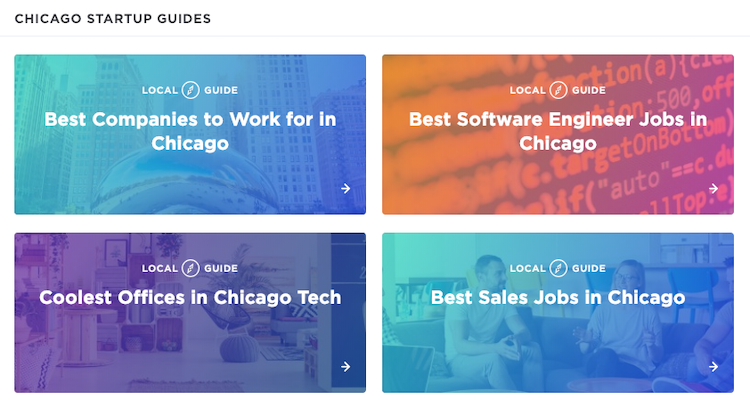
We also distribute a weekly newsletter chock full of content like featured blog posts, job openings, upcoming events and, of course, links to all of our social media channels.

In addition to written content, we host a variety of events. One of our most popular events for both tech companies and candidates is our Built In Brews series. Each month we host an event for an individual tech company looking to hire and we open the talent tap.

We also include upcoming events on our local websites, in newsletters and as part of our social media campaigns to reach the broadest audiences and make sure our partner companies stay top of mind.
The result is a thriving community of engaged and informed tech candidates that allows us to help our partners make thousands of hires every year.
2. IHS Markit's Talent Community

IHS Markit offers anyone who lands on their careers page the opportunity to join their talent community. They understand that many candidates may not know what a talent community is, so they provide a brief explanation of what candidates gain by joining.

The form is simple to fill out and it includes areas of interest and expertise as well as the ability to upload a resume. Not only does this provide IHS Markit with a wealth of information about candidates, it also helps them provide tailored content to candidates based on the information they provide.
Once signed up, this is the first email a candidate receives.

They keep it short and sweet with an overview of the information members can expect to receive, and they require people to opt-in after this email. That is important not only for potential legal responsibilities but also to ensure that the people who join your talent community are fully aware and understand what they signed up for.
They also include large buttons to all of their top social media channels — an essential for every newsletter.
3. Drift's Talent Community
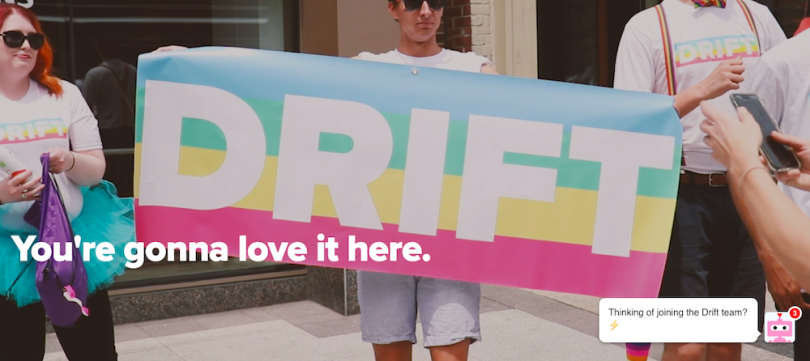
Drift straight up NAILS building a talent community. The variety of content they create for recruiting and building a talent community is phenomenal. Let’s take a look at their process.
First off, notice in the image above there’s a little chat bot specific to recruiting that asks “Thinking of joining the Drift team?” This is what it looks like when you engage with the bot.
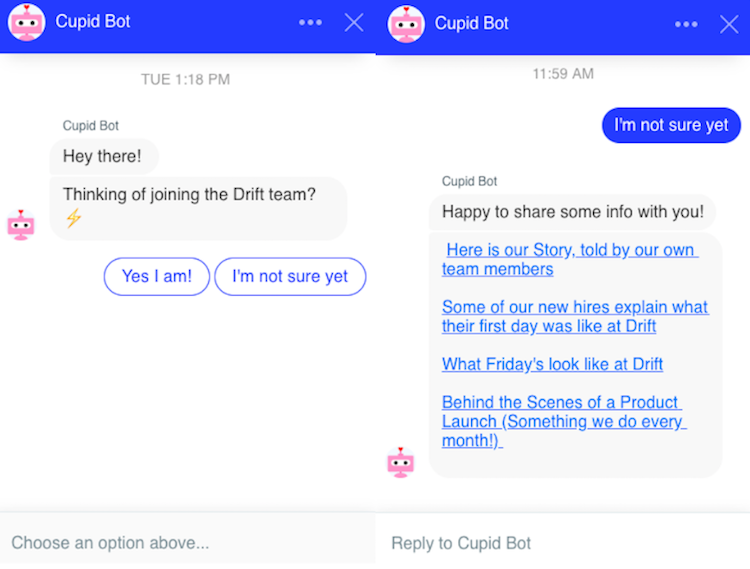
The bot delivers Q&A options to provide tailored content based on where candidates are in the application process. I clicked “I’m not sure yet,” and they offered four separate links to videos on their Youtube channel that would be useful and interesting to someone still learning about the company as an employer.
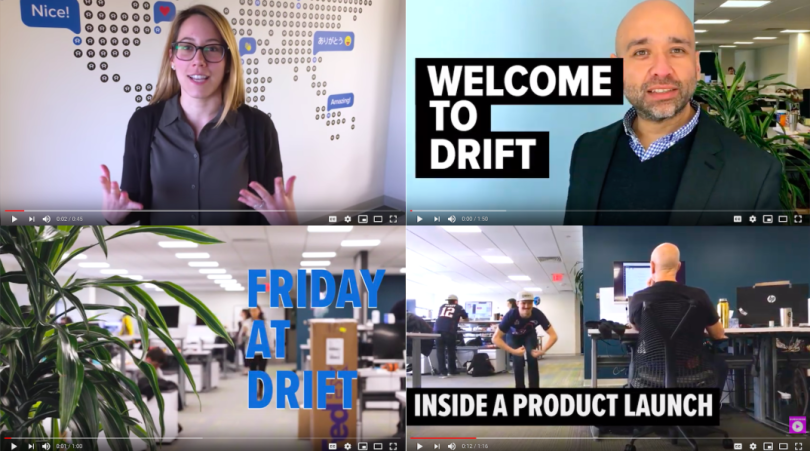
At the bottom of the page, they offer another opportunity for candidates to join their talent community. This time they provide links to all of their social channels, and have a specific hashtag for their talent community for prospects to see what employees share about their workplace.
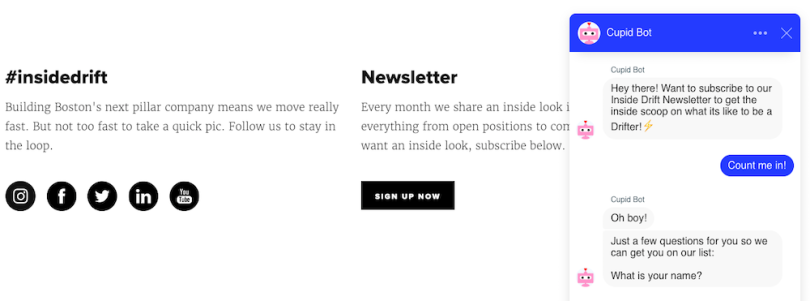
They also have a sign up option for their monthly newsletter, but they don’t just allow people to sign up willy nilly. When you click the 'sign up now' button, another chatbot opens up that asks a few specific questions about the candidate, like their contact information and the industry they work in.
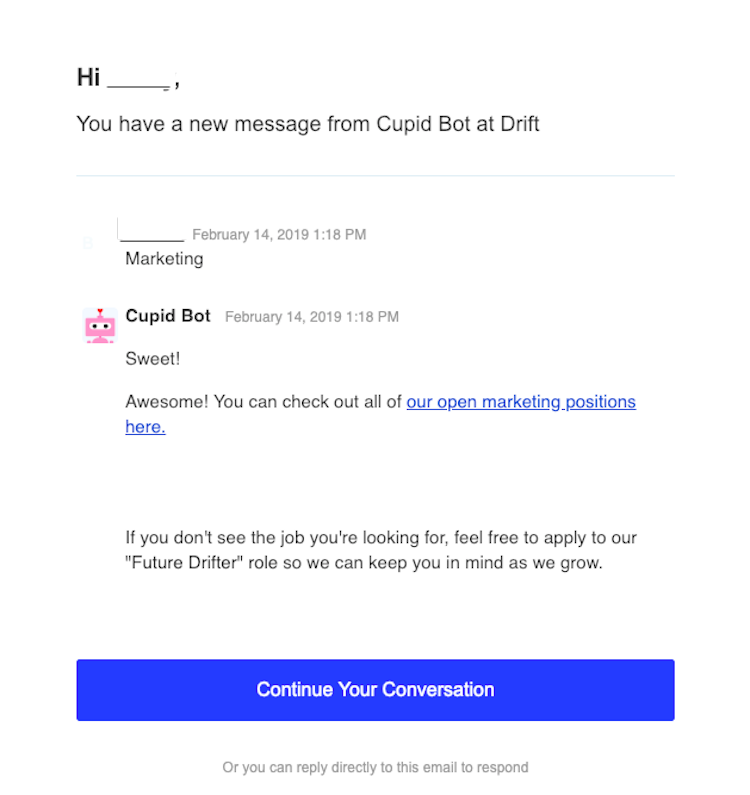
Once you’ve opted in to the email newsletter, this is the first email candidates receive. Because they asked specific questions in the email sign up, they’re able to provide tailored content and link directly to specific positions at the company, like marketing. Talk about thorough.
4. GE Digital's Talent Community

GE Digital keeps it super simple. Their form page informs candidates of how to sign up for their talent community and what they’ll receive in return. Signing up can be done on LinkedIn, Facebook, by uploading a resume or with an email address. Providing a variety of ways for candidates to sign up ensures no one will be excluded from the community for something as trivial as not having an account for a certain platform.
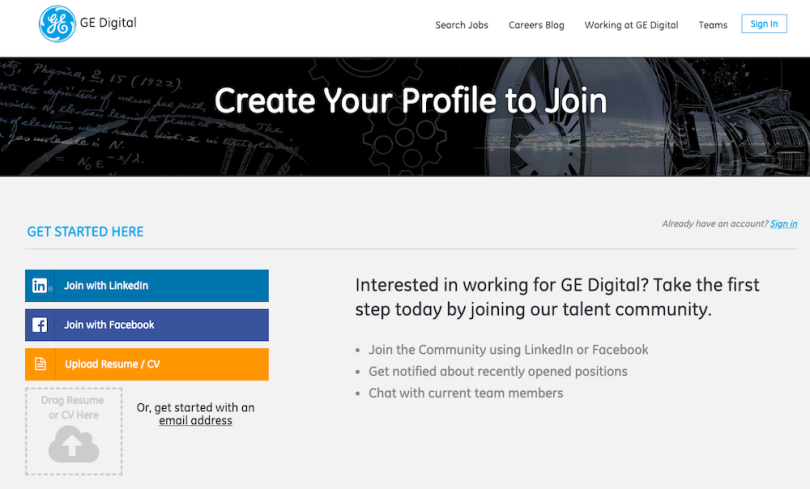
Promptly after signing up, this is the first email candidates receive. They further explain the value of their talent community, what they can expect moving forward as well as links to their social media, blog page, careers page and other pages that provide more information about the company for interested candidates.
